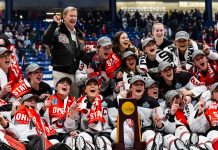XI
They rode from South Bend
In their custom coach.
Once, a fear pierced them,
In that they mistook
The shadow of their equipage
For the foreshadowing of potential victory.
Do the Notre Dame Fighting Irish fear success? How else can you explain a team that looks so darned good on paper never living up to its potential?
This second enigma of the CCHA made its first trip to The Joe in many, many years after the 1999-2000 season, only to follow up last year by sitting out the postseason.
“We were one of the hottest teams at the end of last season,” says Dave Poulin, “but we still fell short by a point and were on the outside looking in when the playoffs started.”
It’s difficult to assess how “hot” the Irish were at the end of last season, but compared to the start of the year, they seemed to be playing better. With just four wins in the first half of 2000-01, the Irish finished with a 4-3-2 record in February and March.
“The challenge for us is to pick up where we left off and get back to where we want to be, and that’s among the top teams in the league,” Poulin says. “I thought we had shown strong progress the previous two years, but took a step back.”
The Public History of a Campaign that Didn’t Do Very Well
Sometimes numbers lie. These numbers don’t.
Notre Dame was ninth in the CCHA in goal production (2.67 per game), dead-last in goals allowed (3.85), power-play percentage (.113), and penalty killing (.767).
After Dan Carlson’s team-leading 42 and Ryan Dolder’s second with 34, point production dropped off significantly for the Irish last year – and Carlson and Dolder are gone. Returning are Rob Globke, Aaron Gill, and Brett Lebda, each with 26 points, as well as Connor Dunlop (7-12-19). The Irish are hoping that senior Dan Inman will produce as well.
Joining the veterans are two rookies from the United States Hockey League, Cory McLean and Yan Stastny. “Yan Stastny will be an effective player from day one,” says Poulin, “and Cory McLean was one of the leading scorers in the USHL.”
To Build a Defense
The Irish defense is led by team captain and junior Evan Neilsen, who tallied two goals and 10 assists for 12 points and a +1 rating during the 2000-01 season.
As a two-way player, Lebda is always a threat, and Poulin is hoping that Paul Harris, who has seen his share of injuries during his first two seasons, will return to healthy form to contribute to the Notre Dame blue line. Neil Komadoski is arguably the most consistent stay-at-home Irish defender to return this season.
Two freshman defensemen whom Poulin hopes will contribute right from the start are Derek Smith and Joe Zurenko. Smith hails from the U.S. under-18 Developmental Team, while Zurenko is a product of the USHL.
“I’m thrilled about our defense for this coming year,” says Poulin. “We were young last year and the younger players got a chance to play in all the tough situations and learned a great deal because of the opportunity. They learned from their mistakes and really showed great progress as the season went on.”
The Oblong Cage
Poulin sums in one word the one area where the Irish most need improvement: “Goaltending.
“That’s just a given. There’s a competition going on right now, you can believe that.”
Veterans Jeremiah Kimento and Tony Zasowski will be vying for time with newcomer Morgan Cey. Irish netminders (including Kyle Kolquist) combined for a goals against average of 3.78 and an .883 save percentage.
Cey led the Flin Flon Bombers of the Saskatchewan Junior Hockey League to the Royal Bank Cup finals last season, earning the SJHL’s Most Valuable Player award with a record of 35-16-0 and a 2.62 GAA.
Tell-Tale Heart
Poulin’s enthusiasm and the Irish squad’s on-paper talent notwithstanding, Notre Dame has a long way to go before becoming a top-tier team. Were it not for the new playoff format — in which every team plays postseason — I’d wonder whether the Irish weren’t ready to repeat their fate of last season.
Will the real Notre Dame Fighting Irish please stand up?


